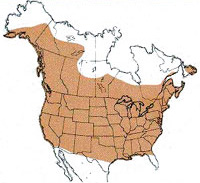Migratory
Grasshopper
|
|
|
|
Geographic range of Melanoplus sanguinipes (Fabricius) |
|
|
Distribution
and Habitat
Economic
Importance
Food
Habits
Migration
and Dispersal
Identification
Hatching
Nymphal
Development
Adults
and Reproduction
Population
Ecology
Daily
Activity
Selected
References
Click here for the printable version
Distribution and Habitat
Widely distributed in North America, the migratory grasshopper, Melanoplus sanguinipes (Fabricius), lives in a multitude of habitats. It is a common inhabitant of grasslands and meadows. Host plants include many kinds of forbs and grasses. Depending on availability of plant species, it may be either a mixed herbivorous or a forbivorous feeder.
The migratory grasshopper has adapted exceedingly well to western agriculture. The inadvertent introduction of weeds, plowing of sandy loam soils of the prairie for the planting of crops, and overgrazing of rangeland sites have created especially favorable habitats. Introduced weeds have furnished a nutritious and steady supply of food, plowing of sandy soils has resulted in wind-blown drifts that have proved favorable for oviposition, and overuse of rangeland by livestock has reduced grass cover and led to the invasion of weeds. A more recent cause of dense populations are the fields of abandoned cropland that rapidly convert to weeds. All of these sources of outbreaks make the migratory grasshopper a prime candidate for integrated pest management. Suggested methods of control include combining clean culture (weed-free) of crops, elimination of weedy fence rows and roadside strips, judicious use of herbicides and insecticides, planting thick stands of grasses in idle cropland, restoring grasses in depleted rangeland, protecting healthy rangeland from overuse, and annual monitoring of habitats and populations of the migratory grasshopper.
Economic Importance
The migratory grasshopper, a mixed feeder of grasses and forbs, is a serious pest of both crops and grasslands. It causes more crop damage than any other species of grasshopper in the United States. High densities damage and may even destroy fields of wheat, barley, oats, alfalfa, clover, corn, vegetables, and ornamentals. It also attacks vines, bushes, and trees, feeding on foliage, fruit, and bark. Populations that irrupt on weedy rangeland and in idle cropland may migrate in massive swarms to infest land miles away. After flight, the migrants may number from 60-140 per square yard, wreaking havoc on the vegetation of the landing area - rangeland, crops, or urban gardens.
Small grains are especially vulnerable to depredations of the migratory grasshopper. Losses of a wheat crop may occur in several ways. An early hatch of grasshoppers may completely destroy newly germinated seedlings of spring wheat. This occurs when the grasshoppers invade the crop from heavily infested stubble or roadside. Grasshoppers may also hatch within the field of growing plants when the crop is seeded in infested stubble. Gradual defoliation through the growing season reduces yield and quality of the wheat by depressing weight of the kernels. Toward the end of the season, defoliated plants become susceptible to head clipping by grasshoppers, further decreasing yield. The grasshoppers feed on green areas of the stem close to the head, causing the head to fall to the ground. A fourth way in which the migratory grasshopper damages wheat is the invasion in late summer of second generation nymphs and adults into the edges of newly emerged winter wheat. The grasshoppers consume the young plants to ground level. Row after row of seedlings are killed as the grasshoppers eat their way from the edge toward the center of a strip or field. This sort of damage occurs in western Kansas and surrounding regions where strip cropping of winter wheat is practiced. Dispersal of a light infestation of one grasshopper per square yard in a fallow strip of wheat stubble to an adjoining field margin of young growing wheat concentrates the infestation to 55 grasshoppers per square yard.
High densities of the migratory grasshopper infesting rangeland seriously deplete forage for both livestock and wildlife. The grasshoppers not only feed on native forbs and introduced weeds but also on valuable forage grasses. In the desert prairie of Arizona where this species frequently reaches outbreak numbers, the grasshoppers damage blue grama, curly mesquite, red sprangletop, squirreltail, and stinkgrass as well as a variety of forbs and weeds. In the mixedgrass prairie the migratory grasshopper attacks several native grasses including blue grama, western wheatgrass, bluegrasses, and sand dropseed. A severe outbreak of the migratory grasshopper occurred in the mixedgrass prairie of South Dakota from 1937 through 1939 and an unusual but severe outbreak occurred in the bunchgrass prairie of British Columbia during 1944. In the latter case populations destroyed 70 to 80 percent of grasses on the open range.
Much variation in size of the migratory grasshopper exists among specimens taken from different habitats and regions. Live weights of males collected from a ranch roadside in eastern Wyoming averaged 338 mg and of females 442 mg (dry weights 112 mg and 151 mg, respectively).
Food Habits
Examinations of gut contents show that the migratory grasshopper is usually feeding on several species of plants growing in its habitat. This behavior is important in its ecology because laboratory studies have demonstrated that a mixed diet affords individual grasshoppers better nutrition. Although polyphagous, the migratory grasshopper selects host plants from its habitat. Preferred foods include dandelion, tumble mustard, wild mustard, pepperweed, western ragweed, downy brome, Kentucky bluegrass, barley, and wheat. Nymphs and adults ingest dry materials lying on the ground surface including plant litter, cattle manure, and bran flakes.
Dispersal and Migration
The migratory grasshopper, as the common name implies, often disperses and migrates. Many accounts of adults swarming have been published, although there are few records of nymphal migration and still fewer accounts of adult migration in the absence of mass swarming. Recent research has revealed that migratory behavior is inherent and regularly displayed, although considerable variability occurs among populations. The greatest degree of migration has been found in populations inhabiting areas where resources are patchy and unpredictable, as in Arizona and New Mexico. The least degree of migratory behavior was detected in a population inhabiting a relatively lush and stable environment in Colorado.
The older nymphs, third to sixth instars, may migrate as far as 10 miles but usually the distance is less than 5 miles. The nymphs travel together in a band at rates of around 0.1 mile per hour.
Adults are highly migratory in their prereproductive stage. Swarming occurs on clear days when temperatures approach 80°F and winds are gentle and intermittent. Migrants take off into the wind and then turn around and fly with the wind at speeds of 10 to 12 miles per hour. They usually begin flight in late morning, fly during the middle of the day, and alight in the afternoon to feed and rest. With favorable conditions the following morning, they continue their migration. From trials of marked adults, individuals are known to travel 30 miles in a day and probably fly much farther. In 1938 one record of migration indicated a swarm averaged 66 miles per day for four days, flying from Highmore, South Dakota to Beach, North Dakota. The longest migrations recorded in 1938 were made by swarms that traveled from northeastern South Dakota to the southwestern corner of Saskatchewan, a distance of 575 miles.
Flights of the migratory grasshopper have been designated as low flights (25 feet or less above the ground) or high flights (more than 25 feet above ground). The high flights occur at various elevations. Pilots of observation aircraft in the grasshopper control program have encountered swarms flying 1,000 feet above ground and pilots of ferrying aircraft have encountered swarms 2,000-3,000 feet above ground. Pilots of commercial aircraft have reported encountering swarms at all elevations up to 13,000 feet above sea level (about 8,000-9,000 feet above ground).
Migrating or milling swarms can be observed by cupping a hand over one eye and looking toward the sun with the other. The flying grasshoppers reflect the sun's rays and this shimmer of light can be seen at great distances.
Identification
|
Figures 1-5. Appearance
of the nymphal instars, their sizes, structures, and color
patterns. Notice progressive development of wing pads. BL=body
length, FL=Hind Femur Length. AS=number of antennal segments
|
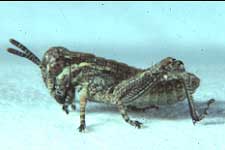 |
|
Fig. 1,
First Instar: BL 4-6 mm FL 2-2.9 mm AS 12-13.
|
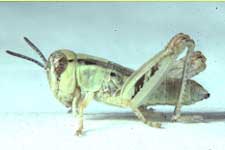 |
|
Fig. 2,
Second Instar: BL 6-8 mm FL 3-4.3 mm AS 15-17.
|
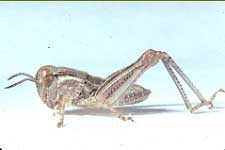 |
|
Fig. 3,
Third Instar: BL 8-11 mm FL 5.5-6.1 mm AS 18-20.
|
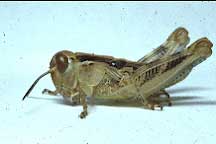 |
|
Fig. 4,
Fourth Instar: BL 11-16 mm FL 7.6-8.6 mm AS 21-22.
|
 |
|
Fig. 5,
Fifth Instar: BL 16-23 mm FL 10-13 mm AS 22-24.
|
|
Figures 6-10. Appearance
of the adult male and female, cercus, note notch, and egg
pod.
|
 |
|
Fig. 6,
Adult Male: BL 20-26 mm FL 11-12.5 mm AS 24-27.
|
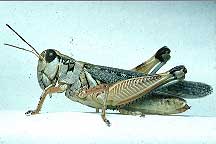 |
|
Fig. 7,
Adult Female: BL 20-29 mm
FL 12.3-14 mm AS 25-27.
|
 |
|
Fig. 8, Side view
of end of male abdomen.
|
 |
|
Fig. 9, End view of
male abdomen, showing notch in the subgenital plate.
|
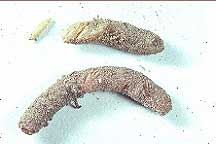 |
|
Fig. 10, Egg pod and
exposed eggs in bottom of broken egg pod.
|
The migratory grasshopper, Melanoplus sanguinipes (Fabricius), is a medium-sized representative of this large genus. Adult males (Fig. 6) are easily identified by the shape of the cercus (Fig. 8), the notch of the subgenital plate (Fig. 9), and the node or bump on the mesosternum. The females (Fig. 7) are slightly larger than the males and can be associated with them and distinguished by their similar color patterns. The hind tibiae are blue green or red.
The nymphs (Fig. 1-5) are identifiable by their color patterns:
- Compound eye with many light spots, narrow brown bar across middle.
- Narrow pale yellow crescent on gena below eye and continuing on pronotal lobe to principal sulcus.
- Hind femur with dorsal black stripe cut in middle by light bar; a light bar on each end.
- Hind tibia of first instar fuscous with pale basal ring; hind tibia of other instars pale blue green or reddish without pale ring.
- General color of body tan or gray, few light green.
Hatching
The migratory grasshopper is an early-hatching species, appearing on rangeland about one week after the bigheaded grasshopper begins to hatch. Several environmental factors, especially soil temperature and moisture, affect the exact timing and duration of hatching. Hatching starts first along open south slopes, in fields and rangeland with little vegetative cover, and in sandy soils. The duration of hatching is shortened by uniform soil and vegetation and high temperatures, and may be completed in three weeks. Hatching is retarded by heavy clay loam soils and by tall vegetation that shades the ground. A mosaic of these conditions in an area, as well as below-normal temperatures, may extend the hatching period to six weeks. For complete embryonic development the eggs require 527 day-degrees above a threshold of 50°F soil temperature. Under favorable conditions 80 percent of development occurs during the summer that the eggs are laid and 20 percent the following spring. In warmer areas of the West, as in Kansas, the migratory grasshopper produces a smaller (less numerous) second generation each year. The majority of eggs of the first generation enter diapause and hatch the following year.
Duration of embryonic development and stage of embryonic diapause are greatly influenced by the climate of the occupied area. Grasshoppers from warmer environments tend to diapause at early stages of embryonic development while grasshoppers from cooler environments diapause at later stages. This seeming paradox is due to populations evolving adaptations to prevailing lengths of season.
Nymphal Development
Nymphs grow and develop during late spring when days are long, weather is usually warm, and food plants are green and abundant. Under these favorable conditions the young grasshoppers pass through the nymphal stage in 35 days. Cool weather, however, may lengthen the nymphal stage to 55 days. Nymphal instars range from five to six; the females usually require the larger number.
A study of six populations of the migratory grasshopper residing in habitats lying along an altitudinal gradient in California revealed significant variations in nymphal period and other life cycle parameters. Both nymphal development and adult maturation were accelerated at high altitudes relative to sea level. The phenological differences were attributable partly to environment and partly to genetic divergence of the populations.
Adults and Reproduction
Emergence of adults begins the first part of summer and may continue for three or four weeks. The first adults to emerge have the best chance for reproductive success. At this time there is likely to be an abundance of green food plants to provide the nourishment necessary for rapid egg production. In addition, the first eggs laid will usually experience more favorable soil moisture and have a longer time to reach an advanced developmental stage before entering diapause.
The females have a preoviposition period of two to three weeks. During this time they increase in weight, mate, and mature their first group of 18 to 24 eggs. The male is able to recognize a mature, virgin female and performs a short courtship in which he waves his antennae and vibrates his hind femora before he makes a sudden copulatory leap onto the female. A mated female oviposits about six days later and takes nearly an hour to lay a clutch of eggs. Healthy adults copulate many times during the reproductive period.
The females deposit their eggs on rangeland among the roots of blue grama or other grasses. In cropland they often deposit them around the base of wheat stubble or alfalfa. Pods are curved, one inch long and one-eighth inch in diameter. The top half of the pod, containing dried froth, is oriented vertically in the soil and the bottom half, containing the eggs, is oriented diagonally. The midpoint of the clutch is three-fourths inch below the soil surface. Eggs have a banana-like shape, are 4.5 mm long, and pale yellow or cream colored (Fig. 10). Under laboratory conditions, a long-lived female may produce as many as 20 pods and a total of 400 eggs. The average fecundity in nature is unknown, but it may not be more than 20 eggs.
Population Ecology
The population ecology of the migratory grasshopper has received much study by scientists in Canada and the United States. Their findings indicate that the two most influential factors affecting population growth of this grasshopper are weather and food plants. Although the species feeds on a large variety of plants, a limited number are particularly favorable for survival, growth, and reproduction.
The migratory grasshopper has a great capacity for increase. Large populations develop in disturbed or cultivated land such as weedy rangeland, stubble of small grains, reverted fields, and roadsides. In a favorable year, a noneconomic population of three adults per square yard can reproduce exponentially so that in the next year the population may reach an outbreak density of 30 adults per square yard. Over a period of several favorable years, densities may reach enormous levels. In 1938 in northeastern South Dakota, densities of the migratory grasshopper reached 1,500 to 8,000 nymphs per square yard in cropland, idle land, and weedy rangeland. Less than ideal weather and natural enemies (predators, parasites, and diseases) usually keep populations from increasing to such an extent. Densities normally range from zero to nine nymphs and zero to three adults per square yard.
Weather is important to the health of this grasshopper and consequent population growth. An early, mild spring allows the nymphs to flourish and a large percentage to become adults. On the other hand, cool wet weather and heavy rains in spring cause much mortality among young nymphs. A mild fall with intermittent rains keeps food plants growing and lengthens the longevity of adults, which allows them to continue reproducing.
The migratory grasshopper resides, usually in small numbers, in all types of grassland habitats. During outbreaks of grass-feeding species on good-condition rangeland, the migratory grasshopper is present in the assemblage at subdominant densities of 0.1 to 3 young adults per square yard. This is in contrast to its often dominant position in weedy depleted rangeland, where it reaches densities of 20 to 60 or more young adults per square yard. The latter densities exhaust the forage, inducing the grasshoppers to take wing and migrate to "greener pastures."
A study of a severe outbreak of the migratory grasshopper in northeastern South Dakota revealed a gradual increase in density from 1934 to 1936. In the spring of 1937 very severe infestations of nymphs (80 plus per square yard) hatched and survived in many sites. From these sites adults spread throughout the area. Unusually warm weather in September and October allowed the females to lay over an extended period, producing as many as 8,000 eggs per square yard in idle land and depleted rangeland. This extraordinary reproduction resulted in an enormous outbreak during 1938 that eventually led to mass flights of the young adults. Because of the migrations, the outbreak expanded and continued through 1939. It ended in 1940, due, at least in parts of the extensively infested area, to a cool, wet spring that caused high mortality among the nymphs.
Daily Activity
The migratory grasshopper is normally active during the day and inactive at night. In rangeland habitats most nymphs and adults spend the night resting horizontally on the ground. A few, however, climb vegetation and rest vertically head up at heights of 8 to 24 inches. When the rising sun strikes them in the morning, they adjust their positions to receive the full benefit of the warming rays. They may bask either on the ground or on vegetation. The common orientation is to turn a side perpendicular to the sun's rays and lower the associated hindleg to expose the abdomen. After basking for approximately two to three hours they become active, walking about and feeding. Later in the day they have been observed to mate and oviposit. When soil temperatures rise, those occupying bare ground may stilt. As temperatures rise still further (soil approximately 130°F, air 90°F at 1 inch level) many individuals climb vegetation, often the stems and culms of western wheatgrass, to heights of 2 to 8 inches. When temperatures moderate in late afternoon, they again become active, pottering, feeding, mating, and ovipositing. Before taking their nighttime positions, they bask for a second time. J. R. Parker (1884-1972), a renowned student of grasshopper biology, has described in detail the influence of temperature on the daily activities of the migratory grasshopper (Montana Agr. Exp. Stn. Bull. 223, 1930).
References
See list of selected field guide references. In grasshopper literature the scientific name of the migratory grasshopper has been given as Melanoplus mexicanus (Saussure), later Melanoplus bilituratus (Walker), and finally Melanoplus sanguinipes (Fabricius).
